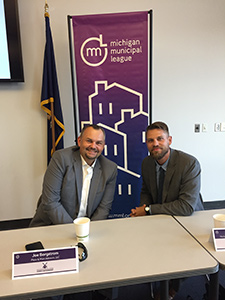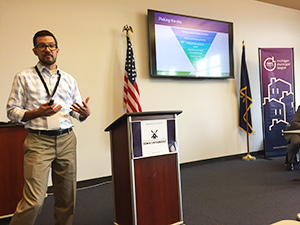 Nearly every community has some blighted properties that have sat vacant or dilapidated for far too long. The challenge is how to transform those sites from a liability to an asset. That’s where the panelists in this session come in. They offered a variety of techniques to make those sites a source of pride and vitality in the community.
Nearly every community has some blighted properties that have sat vacant or dilapidated for far too long. The challenge is how to transform those sites from a liability to an asset. That’s where the panelists in this session come in. They offered a variety of techniques to make those sites a source of pride and vitality in the community.
Ryan Kilpatrick, Senior Community Assistance Specialist, Michigan Economic Development Corporation
Kilpatrick touted the benefits of Redevelopment Ready Communities®, the Michigan Economic Development Corporation’s flagship technical assistance program. The program is designed to help communities focus on getting ready for the next stage of growth and dealing with shifting markets. Fortifying strategies and processes in a number of areas is key:
- Community plans and public outreach – Engage the community in developing a vision for the subject site(s).
- Zoning regulations – Adjust your zoning regulations, if necessary, to achieve the desired outcome on the subject sites(s).
- Development review process – Ensure that your review process is developer-friendly while still meeting your goals.
- Recruitment and education – Seek out motivated, highly-qualified people for staff as well as volunteer positions on zoning boards, planning commissions, etc.
- Redevelopment ready sites – Have at least a handful of sites in your community that are ready for development to show to developers. MEDC can provide marketing assistance.
- Community prosperity – Tap into the local culture and find a way to articulate it that resonates with current and potential residents and businesses.
Successful Redevelopment Ready Communities® Projects
- Ludington – The city has a privately-owned vacant site in a high traffic area with a current taxable value of $15,000. There is a development proposal on the table from Gibson Homes. They’re proposing to invest $1.6 million to construct a mixed-use project with 1,000 square feet of ground floor commercial and eight 1-bedroom apartments. That would increase the property’s taxable value to $550,000. MEDC grant support is currently under review.
“We want to catalyze the local market,” said Kilpatrick. “We want to help prove that this kind of project is financially viable for other developers.”
- Zeeland – A local business owner wants to expand his downtown office onto an adjacent vacant parcel.
With an investment of $1.5 million, including a $325,000 grant from MEDC, he was able to construct a new building with 3,800 square feet of commercial space and three 2-bedroom apartments. This project increases the sites’ taxable value to $550,000.
Other Development Tools
The Incremental Development Alliance offers a variety of tools to help developers with small in-fill developments. If a small developer takes a small risk and finds success, he’s more likely to do another project, says Kilpatrick. And 4 or 5 of these projects in a row can transform a downtown.
Joe Borgstrom, Principal, Place & Main Advisors
Joe Borgstrom emphasizes four key steps to move a vacant property forward:
- Market data – Have a good handle on your market, get relevant data such as market leakage reports, household income, who’s in your community and what are their shopping habits, and a target market analysis.
- Willing owner – Find a property with an owner who is cooperative and wants to see something positive happen on the site.
- Property information package – Assemble all the vital information on the site – price,size, utilities, market info, photos – and put it on your website.
- Provide a vision – You want the developer to be a tool for the community’s vision, not the other way around. If you want a mixed-use development, stick to your guns. And be careful about offering incentives. Way too often we don’t calculate the return on investment when considering offering incentives, says Borgstrom.
Successful Projects
- Jackson – The city had a vacant lot downtown that probably would have attracted a strip mall. Jackson wanted something different, so they created an RFQ for a cool, mixed-use development. Thy were able to attract a developer with experience in building what they wanted. Lofts on Louis – a four-story mixed used development with first floor retail and 30 apartments – is now under construction.
- Grayling – There are no commercial apartments in the city, but a target market analysis showed that they needed 400 units to accommodate 300 incoming jobs. The TMA revealed that the best site for developing apartments was a golf course near downtown. The golf course is now considering adding 24 units of multi-family to their site, which would provide them with cash to keep operating the golf course.
- Norton Shores – For a long time, Kmart didn’t return phone calls about the future of their vacant store in Norton Shores. The city came up with a vision for mixed-use development along the U.S. 31 corridor, which included the Kmart site. They shared the vision with Kmart, and they’re now interested in selling their site.
Richard Murphy, Project Coordinator, Michigan Municipal League
 “Planners can make the best plans in the world, but they need developers to implement them,” said Richard Murphy.
“Planners can make the best plans in the world, but they need developers to implement them,” said Richard Murphy.
That’s the basis for the Michigan Municipal League’s current partnership with the Michigan State Housing Development Authority. MSHDA approached the League about helping attract developers to vacant sites around the state.
To get the project off the ground, the League identified some communities with sites ready to go and helped them develop an RFQ – Request for Qualifications. An RFQ lays out the specifics of the site, what the community would like to see developed on it, and asks for the developer’s qualifications to accomplish that goal. This approach lets developers know that the community has a vision for the site and they want to develop a relationship with the developer.
Here are some key steps to develop and implement an RFQ:
- Vision – Work with community stakeholders to create a vision for the site that meets the community’s needs.
- Set expectations – Before accepting proposals, consider the financial reality of the site. Can you actually build what you want there? Will the market support the desired development? Are incentives needed to fill the gap?
- Catch attention – Tell the story of our site in an attractive marketing package that doesn’t overwhelm potential developers with too much information. Provide the essential information with links to more detailed data, such as zoning ordinance.
- Broadcast widely – Don’t rely on just putting the information on your website. Use other tools, such as RRC’s Opportunity Michigan book, Zoom Prospector, developer organizations, and direct distribution.
- Find developers – Get in touch with existing firms, such as the Urban Land Institute and the Homebuilders Association. Also consider local business owners, contractors and landlords.Other helpful sources include CEDAM Real Estate Boot Camp and IDA Small Developer Boot Camps.

